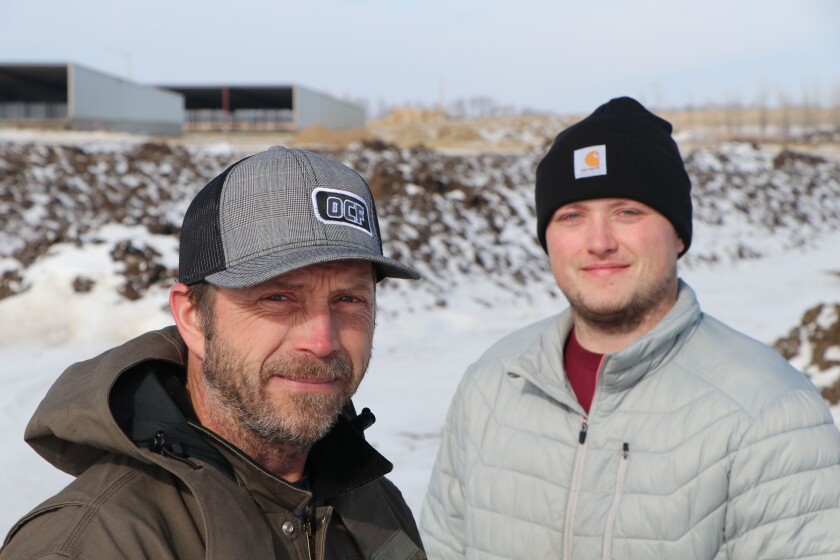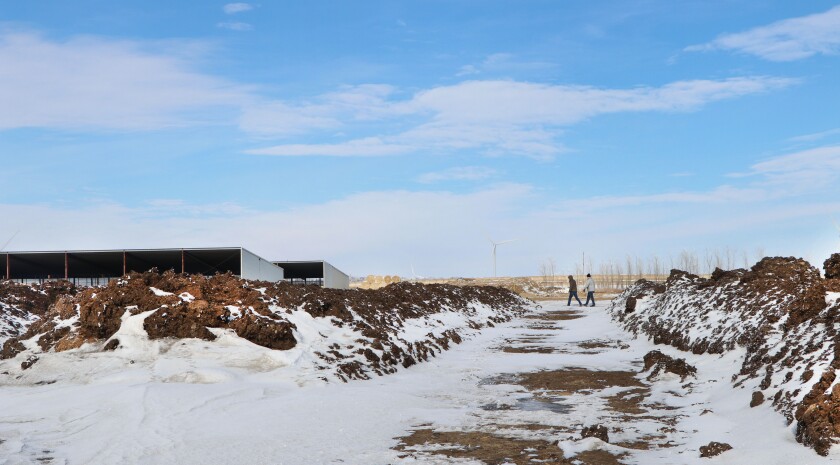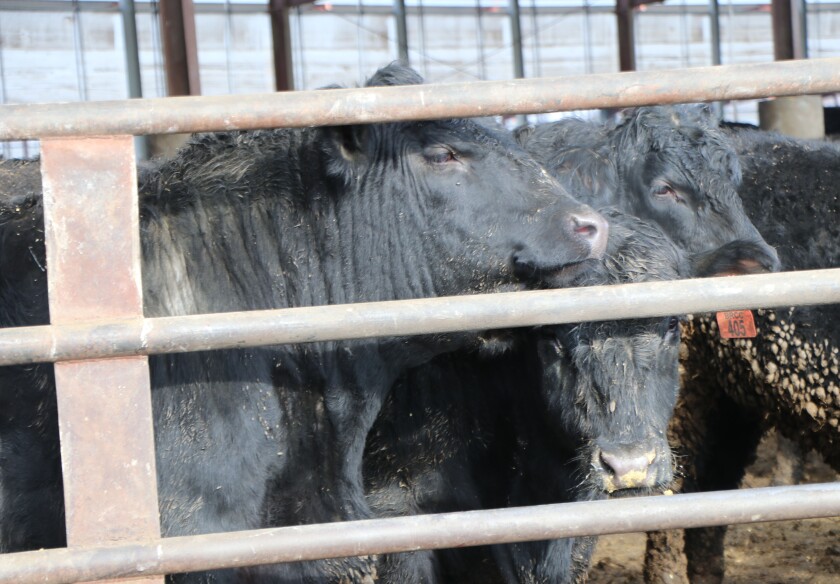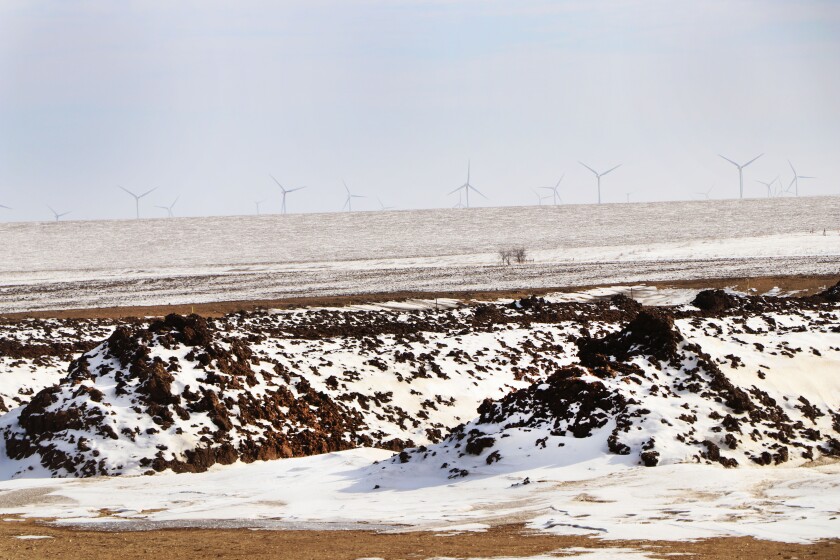TORONTO, S.D. — A custom feedlot near the South Dakota-Minnesota border is fast becoming an innovator in turning bedded pack manure into a value-added soil additive — “humus compost.”
Owners Chad and Pam Olsen and their Olsen Custom Farms at Hendricks, Minn., is most widely known for their custom harvesting operation . They have invested in a composting enterprise they hope will displace synthetic fertilizers , adding value at home and for new customers.

Olsen Custom Farms operates a crop and livestock farm that stretches about 30 to 40-miles on both sides of the state line. On the west side of their spread, they established a 3,500-head custom cattle feedlot system, visible from Interstate Highway 29, about five miles west of Toronto, S.D.
ADVERTISEMENT

“Manure management is tough at the feedlot,” Olsen said. “We only have so many acres to cover raw manure with, close to the feedlot.” That’s true for most confined animal feeding operation — CAFOs.
( For more on the 2021 Agweek Livestock Tour click here. )
Bedded pack

The farm's agronomist, Kurt Dagel, urged the Olsens to get into humus (HUE-mus) composting.
Dagel grew up in Watertown, S.D., before moving to North Dakota, where he graduated from Grand Forks Central High School. He pursued his bachelor’s degree in botany and his master’s in agronomy from South Dakota State University. He started his career with the U.S. Forest Service at Rapid City and worked 20 years as a technician with the Agricultural Research Service in Brookings, before coming to Olsen Custom Farms five years ago.
ADVERTISEMENT
Dagel noted the manure from the feedlot was covering less than 10% of the farm’s acres, simply because it’s too expensive to ship the water.
“I quickly identified that the nutrients that are produced at this site could, basically, cover 75% of our fertility needs for our entire farm,” Dagel said.

But he had to convince the Olsens to invest about $1 million in the humus composting.
The farm spent about a half-million dollars in the dirt work alone. The 14-acre site is a clay-lined pad, with a 12-foot-deep clay-lined basin, designed to capture any runoff. The farm also spent another half-million dollars for the equipment — a tractor, a specialized “turner” machine, a skid loader, a payloader and a litter spreader for the fieldwork. Ongoing, the project will require two full-time employees and one part-timer, Olsen said.
Instead of the “standard” manure conditioning most farmers are familiar with, the humus composting takes 12 weeks.
ADVERTISEMENT

12-week process
“Humus compost requires (incorporating) 10% to 15% clay, by volume, which is a binding agent, so to speak, for the nutrients that are in the manure, so we don’t lose them. It densifies our product so it’s better to spread and it has more soil health properties than standard compost,” Dagel said.
Olsen Custom Farms actively composts from April through November, only interrupted by rainfall events.
As they clean out the “monoslope” roof barn, the manure pack starts at 40% to 60% moisture. The crew removes it from the barn and lays it in 36 windrows — 14 feet wide at the base, 6.5 feet tall and 160 feet long. The windrows start as pairs and after six week have lost half of their volume and are combined.
ADVERTISEMENT

For the first eight to 10 weeks, the farm turns the compost every day. The primary tool is the Aeromaster PT-170 — a compost turner, designed to handle operations of more than 35,000 tons per year. The turner comes with a water tank, for adding water and inoculants.
The tractor drives along at about a third of a mile an hour pulling the 14 foot-wide turner system. In a single pass, the operator aerates, blends and adds water and inoculant microbes. The inoculants build the material into humus, the dark, organic material that forms in soil when plant an animal matter decays. The characteristic manure smell dissipates within about a week.
The process adds oxygen, Dagel said. It’s an “aerobic” process, which risks going “anaerobic” if improperly managed.
The turner drum rotates at 150 to 300 rpm, enhancing compost without pulverizing, which can retard the composting process. Farm personnel use a thermometer daily to check to keep the temperature at 130 to 160 degrees.
That temperature “kills pathogens, weed seeds, those sorts of things. You’ve got to keep your compost at 40% to 50% moisture” Dagel said.
World experts
Olsen Custom Farms follows methods touted by Midwest Bio-Systems, Inc., of Tampico, Ill., a company that makes equipment, trains employees and provides ongoing consulting.
ADVERTISEMENT

Midwest Bio-Systems was started in 1984 by Edwin Blosser, who runs various businesses, including some in partnerships involving organic chickens, and “renewable” farming systems.
In 1992, Blosser traveled to Europe to study the “humus compost” techniques. In 1993, he started a factory to make Aeromaster Composting Equipment.
Midwest Bio-Systems says it has about 400 of compost turner systems in the field.
Dagel said the system cost $200,000, with all of the bells and whistles.
In Midwest Bio-Systems literature, the company acknowledges CO2 is released in their process. But it is part of a natural process and is not considered “man-made” and therefore isn’t figured into greenhouse gas emission calculations, according to the company’s online literature.
ADVERTISEMENT

“Actually, composting, when done properly … reduces greenhouse gas a great deal, (especially methane and nitrous oxide, which are considered far more dangerous than CO2) when compared to simply dumping an equivalent amount of organic waste into a landfill,” the company says.
Dagel works with Trent Johnson, another Olsen Custom Farms agronomist, on marketing the humus compost to farmers and others. Originally from Hendricks, Johnson also holds an SDSU agriculture business degree and agronomy minor. Johnson worked for two years with the Lincoln County Soil and Water Conservation District at Ivanhoe, before joining the farm in June 2020.
Johnson said the farm will sell the humus compost by the ton.
They’re working on pricing. For sure it will be more valuable than traditional synthetic, or mineral fertilizers, because it adds such “soil function,” including water storage, and increasing soil aggregates. They also may market “humus compost extract” — a liquid which is something farmers can spray as the crop emerges, or in-furrow.
Olsen knows of only one other location in South Dakota that is doing something similar. There are several in the Minneapolis area, turning municipal wastes (lawn clipping, leaves) where the compost is marketed mostly for landscaping.
“That’s going to be another outlet we’re looking at for our manure (compost) also,” Olsen said. “We’re open to move it anywhere in the country.”
Carbon is king

Johnson said many customers think primarily of nutrient values — NPK, or nitrogen, phosphorus and potassium.
“A lot of it’s building soil structure, the way soil functions. Getting mineralization more effective than commercial fertilizers do at times,” Johnson said.
Dagel declared the most important factor for crop growth is in fact the carbon — not NPK.
“Plants get carbon into the soil,” he said. “Livestock consume carbon. We consume carbon. Humus composting is a way to have a carbon-focused fertility program.
“My goal as our farm agronomist is to reduce our nitrogen inputs by up to 75% in the next five years by using a carbon-focused system. Compost is the hub of that.”
Johnson said nutrient analysis of humus compost doesn’t tell the whole story. But it offers nutrients that are plant-available over time because they’re bound with the carbon.
“The humus protein that we’re creating through our humus composting process. That’s the key,” Dagel said. "Carbon feeds microbes in the soil, helps build soil aggregates.
“You either have to grow fertility using free sunlight, or use livestock as part of that process as well,” he concluded. “Livestock should be on every farm. They’re the key to a successful farm from being resource-use efficient."
Farmers must be aware synthetic nitrogen fertilizer production is “one of the largest greenhouse gas emitting industries in the world,” Dagel said.

“It’s going to be regulated so the use of nitrogen is going to be scrutinized,” he said. “We need to learn how to farm with less of it coming out of our own farming enterprise. We have to create circular systems of fertility with our farms. We can’t rely on imported fertility.”
And it’s good business.
“Soils that don’t perform are carbon-depleted. It’s just that simple,” he said. “We might as well get used to starting to farm with carbon as the focus. With the things that could be mandated, we’d rather have a carbon-focused farm. Our fertility program should be focused that way.”









